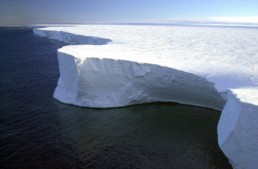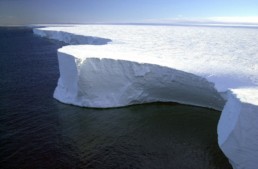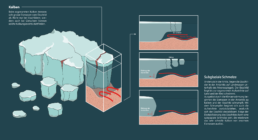The eternal ice and the sea level
Month: January 2020
In 2007, the Intergovernmental Panel on Climate Change warned about the ice sheets melting away in Greenland and West Antarctica. A rise in sea level from four to six meters would be imminent. This could happen within the next centuries, perhaps even millennia. Now researchers from the NGO Climate Central predict in their newest November statement a rise of up to two meters in the year 2100 already. Estimated impacts of global warming have suddenly shifted into the near future and threaten to hit mankind in the form of a rise in sea level as soon as in the next decades. In the meantime, looking into the past shows how fragile the interaction between ice and ocean can be.
Martin Zahno and Luisa, translated by Romuald Bolliger | 01.01.2020
Ellsworth Mountain Range in Antarctica (Image by skeeze from Pixabay)
A rise of one or even two meters does not seems much at first. And yet, if the sea level continues to rise so rapidly, the consequences will be drastic and felt in the near future. Horst Machguth, Professor for glaciology at the University of Freiburg: “Paired with storm tides, such a new sea level will lead to flood disasters.” According to the latest calculations, such extreme events not only occur more frequently due to the increased volume of water, but above all much more regularly. “Areas that are barely above sea level far inland run the risk of being hit by such floods,” Machguth continued. Countries like Vietnam, Bangladesh or the Netherlands, but also cities like Jakarta, Mumbai or Venice would thus already face storm tides in the coming decades. Such scenarios have already been predicted by researchers worldwide in recent decades. However, the period in which such devastating extreme events could occur has now moved much closer to the present. It is no longer a matter of millennia. For example, in its latest report of September 2019, the Intergovernmental Panel on Climate Change assumes that the six meters rise in sea level could be reached as early as 2300. Such a scenario would pose considerable problems for each of the world’s almost 700 million coastal inhabitants. Large areas could thus become permanently inhabitable. The consequences of sea-level rise can thus be regarded as quite threatening for the foreseeable future. The situation is equally alarming when one considers the causes of this phenomenon.
Ice sheet in Antarctica (Image by David Mark from Pixabay)
Where does this rise in sea level come from?
In order to understand the reasons for these new scenarios, one must first distinguish between glaciers and ice sheets. Ice sheets refer to the huge ice masses that are tied up on Greenland and in the Antarctic. Although melding glaciers have little effect on rising sea levels, it is clear that around half of the ice that melts in the world is currently coming from glaciers. “This is mainly due to the large surface area of the world’s glaciers,” says Machguth. Ablation, or melting of the ice, takes place primarily on the surface of the ice mass. “However, this is not sustainable,” the glaciologist continues. “At the time when most of the glaciers have melted away, there will still be a lot of ice left in the Arctic, which will continue to cause sea levels to rise for a long time to come. The ablation Greenland’s glaciers has also increased in recent years, by much more than the 2007 reports estimated.
“Although melting glaciers have little effect on rising sea levels, it is clear that around half of the ice that melts in the world is currently coming from glaciers.”
Greenland’s ice sheet is already contributing significantly to the rise in sea level. Significantly more than the ice that is currently tied up in Antarctica. “The reasons are different”, explains Machguth, “on one hand large parts of Greenland lie far to the south and, on the other hand, it is important to understand that it is much warmer in the Arctic than at the South Pole”. According to the glaciologist, this is partly due to the fact that Greenland is surrounded by large land masses. Antarctica, for its part, has its own climate system due to its location surrounded by oceans where temperatures below freezing point prevail even during summer months.
WIBLO infographic by Luisa Morell
Risk factor Antarctica
However, the fact that Antarctica is anything but a stable system can be inferred by looking into the past. Between the last two ice ages, the global sea level rose by up to nine meters within a relatively short period of about 1000 years, and reaching five meters above today’s sea level at times. Machguth argues that this abrupt rise is not due to the rapid melting alone: “This event was most likely related to enormous calving events in West Antarctica”. During the so-called calving process, entire ice masses break away from the ice sheet and then float to the open sea until they finally melt.
Infobox Antarctica
The estimated maximum ice thickness in the Adélie Land region is 4’776 meters. With a surface area of around 13’924 km2, Antarctica is larger than the EU and around 337 times larger than Switzerland! In addition, Antarctica is subject to above-average winds. Year-round wind speeds of up to 300 km/h are not uncommon.
Ominous is the fact that large parts of the West Antarctic ice sheet, unlike in Greenland, reside on land masses below sea level. If West Antarctica were to destabilize, subglacial melting could follow. The consequence of such a subglacial melt as well as mechanical destabilization would be the rapid calving of enormous masses of ice. With a potential rise in sea level of seven meters in West Antarctica, this remains a threatening idea. “Nevertheless such scenarios are to be taken with a pinch of salt, because this kind of sudden event could in turn affect global phenomena such as ocean currents, which in turn have an impact on climate,” explains Machguth.
Even if the consequences of such a scenario are difficult to fathom, the short-term effects of sea level rise are already evident today. Its impact on the whole of mankind is now slowly becoming apparent and tangible. Consequences of such a process can hardly be stopped, but at best only contained.
Would you like to receive our Newsletter? Please subscribe here Newsletter
If you enjoyed reading this article, maybe you would like to support our work? Thanks a lot!
Ellsworth Mountain Range in Antarctica (Image by skeeze from Pixabay)
A rise of one or even two meters does not seems much at first. And yet, if the sea level continues to rise so rapidly, the consequences will be drastic and felt in the near future. Horst Machguth, Professor for glaciology at the University of Freiburg: “Paired with storm tides, such a new sea level will lead to flood disasters.” According to the latest calculations, such extreme events not only occur more frequently due to the increased volume of water, but above all much more regularly. “Areas that are barely above sea level far inland run the risk of being hit by such floods,” Machguth continued. Countries like Vietnam, Bangladesh or the Netherlands, but also cities like Jakarta, Mumbai or Venice would thus already face storm tides in the coming decades. Such scenarios have already been predicted by researchers worldwide in recent decades. However, the period in which such devastating extreme events could occur has now moved much closer to the present. It is no longer a matter of millennia. For example, in its latest report of September 2019, the Intergovernmental Panel on Climate Change assumes that the six meters rise in sea level could be reached as early as 2300. Such a scenario would pose considerable problems for each of the world’s almost 700 million coastal inhabitants. Large areas could thus become permanently inhabitable. The consequences of sea-level rise can thus be regarded as quite threatening for the foreseeable future. The situation is equally alarming when one considers the causes of this phenomenon.
Ice sheet in Antarctica (Image by David Mark from Pixabay)
Where does this rise in sea level come from?
In order to understand the reasons for these new scenarios, one must first distinguish between glaciers and ice sheets. Ice sheets refer to the huge ice masses that are tied up on Greenland and in the Antarctic. Although melding glaciers have little effect on rising sea levels, it is clear that around half of the ice that melts in the world is currently coming from glaciers. “This is mainly due to the large surface area of the world’s glaciers,” says Machguth. Ablation, or melting of the ice, takes place primarily on the surface of the ice mass. “However, this is not sustainable,” the glaciologist continues. “At the time when most of the glaciers have melted away, there will still be a lot of ice left in the Arctic, which will continue to cause sea levels to rise for a long time to come. The ablation Greenland’s glaciers has also increased in recent years, by much more than the 2007 reports estimated.
“Although melting glaciers have little effect on rising sea levels, it is clear that around half of the ice that melts in the world is currently coming from glaciers.”
Greenland’s ice sheet is already contributing significantly to the rise in sea level. Significantly more than the ice that is currently tied up in Antarctica. “The reasons are different”, explains Machguth, “on one hand large parts of Greenland lie far to the south and, on the other hand, it is important to understand that it is much warmer in the Arctic than at the South Pole”. According to the glaciologist, this is partly due to the fact that Greenland is surrounded by large land masses. Antarctica, for its part, has its own climate system due to its location surrounded by oceans where temperatures below freezing point prevail even during summer months.
WIBLO infographic by Luisa Morell
Risk factor Antarctica
However, the fact that Antarctica is anything but a stable system can be inferred by looking into the past. Between the last two ice ages, the global sea level rose by up to nine meters within a relatively short period of about 1000 years, and reaching five meters above today’s sea level at times. Machguth argues that this abrupt rise is not due to the rapid melting alone: “This event was most likely related to enormous calving events in West Antarctica”. During the so-called calving process, entire ice masses break away from the ice sheet and then float to the open sea until they finally melt.
Infobox Antarctica
The estimated maximum ice thickness in the Adélie Land region is 4’776 meters. With a surface area of around 13’924 km2, Antarctica is larger than the EU and around 337 times larger than Switzerland! In addition, Antarctica is subject to above-average winds. Year-round wind speeds of up to 300 km/h are not uncommon.
Ominous is the fact that large parts of the West Antarctic ice sheet, unlike in Greenland, reside on land masses below sea level. If West Antarctica were to destabilize, subglacial melting could follow. The consequence of such a subglacial melt as well as mechanical destabilization would be the rapid calving of enormous masses of ice. With a potential rise in sea level of seven meters in West Antarctica, this remains a threatening idea. “Nevertheless such scenarios are to be taken with a pinch of salt, because this kind of sudden event could in turn affect global phenomena such as ocean currents, which in turn have an impact on climate,” explains Machguth.
Even if the consequences of such a scenario are difficult to fathom, the short-term effects of sea level rise are already evident today. Its impact on the whole of mankind is now slowly becoming apparent and tangible. Consequences of such a process can hardly be stopped, but at best only contained.
Would you like to receive our Newsletter? Please subscribe here Newsletter
If you enjoyed reading this article, maybe you would like to support our work? Thanks a lot!
Author
Martin Zahno
Illustrator
Luisa Morell
Expert University of Bern
Horst Machguth
Teilen
The Coveted Knight
Month: January 2020
A project team from the University of Berne is working on a new edition of Wolfram von Eschenbach’s epic poem Parzival. The latest edition is almost two centuries old and no longer meets current requirements of textual criticism.
Anika Ruppen, translated by Sabrina Haslimeier | 01.01.2020
Handwriting Z Heidelberg, University Library, Cod. Pal. germ. 364 verse 1.1
Parzival mag der wohl berühmteste Ritterheld der mittelalterlichen Literatur sein. Der zwischen 1200 und 1210 verfasste Roman ist in so vielen Textzeugen erhalten wie kein anderer der Gattung der Artusromane: Laut den Angaben der Projektwebsite (www.parzival.unibe.ch) sind sechzehn Handschriften, ein Druck und 72 Fragmente bekannt, die den Text überliefern. Der jüngste Fund, ein in Mainz vorzufindendes Fragment, wurde im Jahr 2019 gemacht. Dass weitere vollständige Handschriften entdeckt werden, ist heutzutage eher unwahrscheinlich. Fragmente aber – also Bruchstücke von Handschriften – können jederzeit in den Einbänden von lange nicht mehr benutzten Handschriften entdeckt werden. Grund dafür ist die so genannte Makulatur: Primär um 1500 wurden Handschriften mit wertlos gewordenen Texten zerschnitten und das daraus gewonnene, nach wie vor wertvolle und sehr stabile Pergament wiederverwendet. Zumeist fanden Schnipsel und Streifen aus ehemaligen Handschriften ihren Weg auf Einbände von neuen Handschriften und Drucken, wo sie die entsprechenden Materialien verstärken sollten. So bleiben unter Umständen Teile von Textzeugen Jahrhunderte lang in Einbänden von vornehmlich in Bibliotheken gelagerten Handschriften versteckt. Teils zufällig, teils nach spezifischer Suche, werden sie schliesslich wieder aufgespürt.
Handwriting R Bern, Burgerbibliothek of Berne, Cod. AA91 61v verse 308.11
Masterpiece with shortcomings
Karl Lachmann’s edition of Parzival, which hasn’t been superseded to this day, was published in 1833, at a time when the study of vernacular poetry from the Middle Ages was experiencing a real boom. What was once considered a remarkable editorial achievement falls short of present day standards due to deficiencies — the methods used are outdated by today’s standards, even though it’s based on comparatively few manuscripts. Since the number of text witnesses has increased considerably since then, a majority of the manuscripts are not sufficiently taken into account.
“The cooperation with other disciplines such as computer sciences and evolutionary biology breathe new life into the subject.”
Future-oriented concept
In 2001, Prof. Dr. Michael Stolz (then at the University of Basel, since 2006 at the University of Bern) and his research team took on the challenge of preparing a critical re-write of the Parzival novel. In addition to a planned edition in printed book form, data will also be accessible in an electronic format. To establish a foundation, all 89 text witnesses were transcribed and the various groupings of manuscripts were investigated. “To the great advantage of the editors, Parzival’s textual history has already been explored several times and from different perspectives,” explains Dr. des. Mirjam Geissbühler, who has been part of the research team since 2011. At best, this would support our own investigations on previous research findings. However, innovative digital methods would enable cutting-edge possibilities in text editing and analysis. Thanks to electronic storage methods, new possibilities arise, including fresh perspectives on the connections between the different manuscripts.
Handwriting R Bern, Burgerbibliothek of Berne, Cod. AA91 55v verse 282.9
Ensuring accuracy
The project, funded by the Swiss National Science Foundation, has been met with widespread interest. “The digital database resulting from the Parzival project is a real treasure trove for researchers,” explains Geissbühler, who worked intensively with the database in the course of her dissertation. She examined the so-called Manuscript L, which passes on Parzival’s story along with other texts about King Arthur and medieval history.
The complexity of this subject is also reflected in the lengthy duration of the project. Whereas the first fifteen years were spent transcribing the text witnesses and processing them into one edition based on four parallel versions, the focus now lies on revising the text. “Ensuring consistency in this work dating from the pioneer days of digitization is a major challenge. We are working with the utmost care”, Geissbühler says as she explains the relevance of these final stages. For example, checking the edition for consistency as directed by strict guidelines, demands the utmost concentration and precision from the research team.
Handwriting O Munich, Bavarian State Library, Cgm 18 1r verse 3.25
The reputation of medieval literature
A modernized edition for scholarly research is not the only enrichment that the project provides. It also serves to refresh the somewhat outdated image of medieval literary studies. “The cooperation with other disciplines such as computer sciences and evolutionary biology breathe new life into the subject,” says Geissbühler. What the digital component will look like in the future remains uncertain due to the rapid development of technology. Accordingly, solutions for the sustainable safeguarding of research data are also being sought. For the time being, German Studies can look forward to an valuable contribution to its research world — and to a newly illuminated future for the coveted knight, now more accessible than ever—for everyone.
Would you like to receive our Newsletter? Please subscribe here Newsletter
If you enjoyed reading this article, maybe you would like to support our work? Thanks a lot!
Autorin
Anika Ruppen
Expertin Universität Bern







